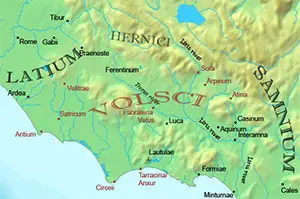Ancient Rome: the Latins
The Latins were a people who lived in ancient times in what is now Italy. They came into conflict with Rome and were eventually subsumed by that civilization. 
Latium was a great plain on the Italian peninsula. The Latins formed small settlements that joined together in religious confederations, first on the Alban Hills. The Etruscans occupied Latium about 600 B.C. and merged its culture with the Latins'. Latin cities included Ardea, Aricia, Crustumerium, Ficula, Fidenae, Gabii, Labici, Lanuvium, Lavinium, Nomentum, Pedium, Praeneste, Tibur, Tusculum. The Latin League, formed in response to the Etruscan occupation, flourished after 509 B.C., when the citizens of Rome drove away Tarquin the Proud, the last king of Rome (and an Etruscan). Tarquin himself made an alliance with the Latins and strove to regain his Roman throne. The Roman victory at the Battle of Lake Regillus ended Tarquin's regal hopes, kept Rome a republic, and resulted in a mutual defense treaty between the republic and the League. At this time, Rome was part of the Latin League and sent troops to fight in the League army, commanded by a dictator. Neighbors who challenged Latin supremacy at this time included the Aequi and the Volsci. Rome eventually outgrew the need for being in the Latin League, and the result was the Latin War, which raged in 340–338 B.C. The Roman victory brought with it the dissolution of the Latin League and Roman hegemony over the League's cities. Citizens of some cities gained Roman citizenship; businessmen in other cities lost their right to free trade. |
|
Social Studies for Kids
copyright 2002–2024
David White




